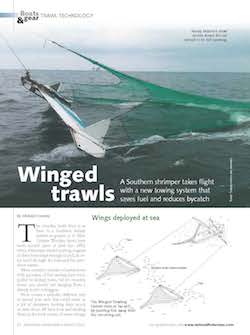In the March 2013 issue of National Fisherman we carried a story on Alabama shrimper Randy Skinner's Winged Trawling System ("Winged trawls," p. 32). Instead of using wood or steel doors to hold open a shrimp trawl, Skinner invented an aluminum wing-like affair that spreads the net apart to its full 100 percent opening.
Thus you don't have to use the power of the boat to keep the net open. That saves fuel. As the wing travels through the water, it pushes fish away from it and the net. That reduces bycatch. The wing, however, doesn't affect shrimp behavior.
The Winged Trawling System, profiled in our March 2013 issue, is designed to save shrimpers fuel and reduce bycatch.Since the winged trawl was introduced it's been mostly used in waters off Skinner's home state, but lately its benefits have attracted the attention of fishermen outside Alabama, even from as far away as Europe.
Fuel savings and bycatch reduction are the two main benefits to using the winged trawl. In a conversation last week, Skinner said his fuel savings are 30 to 50 percent on a 65' x 20' trawler powered by a pair of 350-hp Cummins engines.
"The last trip was 14 days. I burned 2,000 gallons," he said. If he'd towed doors instead of the winged trawl he would have burned 3,000 gallons.
As for bycatch reduction, Skinner said he's been making some "incredible tows — over 50 percent bycatch reduction. Whatever bycatch you get out of a 10-foot trynet equals about what you have out of two 45-foot wings."
Those kinds of results have attracted an outfit in Denmark that runs 80 shrimpers off West Africa. Representatives from that company are due to go out on an Alabama shrimper pulling winged trawls in January.
A pair of winged trawls is headed to North Carolina, where state fisheries specialists will test them. And Skinner said outfits in South Carolina, Florida, Louisiana and Texas have expressed an interest in the winged trawls.
Within the next 45 days a NOAA grant will allow winged trawls to be matched up against traditional doors and a net. "We'll pull trawl doors on one side, pull a wing opposite it with an identical net and do it for 30 days," Skinner said. "We'll document everything that falls out of the net."
The University of New Orleans will be doing the documentation and NMFS in Pascagoula, Miss., will write up the study.
Clearly, Skinner's Winged Trawling System is ready to move beyond the waters of Alabama.







